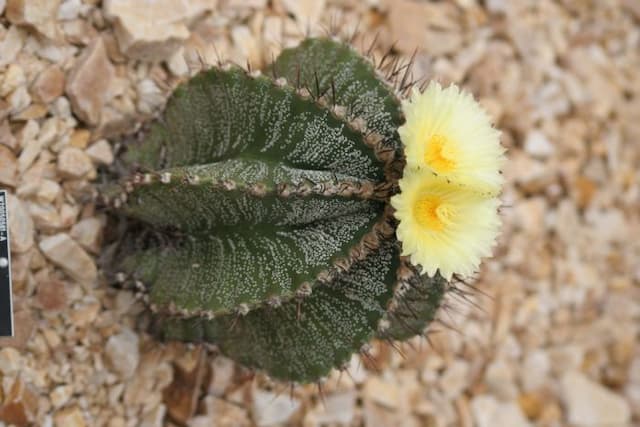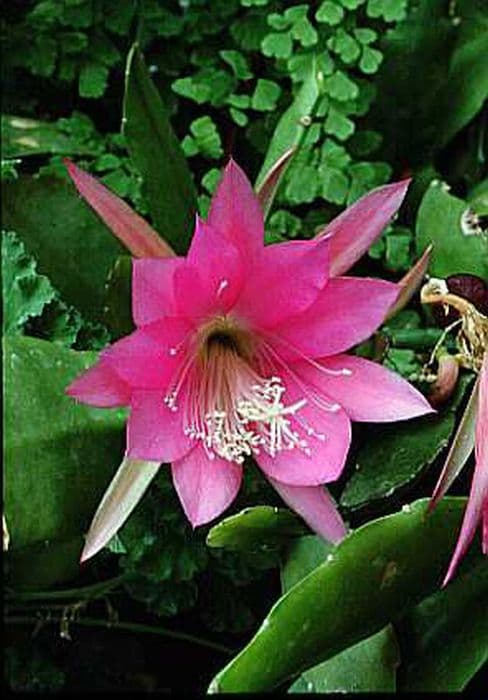Mexican Pincushion Mammillaria magnimamma

ABOUT
The Mammillaria magnimamma, also known simply as the "Mexican Pincushion," is a species of cactus that is characterized by its rounded, ball-like shape. The surface of the plant is covered in cone-shaped protrusions known as tubercles, which give it a textured appearance. Each tubercule is tipped with a cluster of sharp spines that can vary in color from white to yellow or brown. The spines provide the plant with protection from herbivores and help to shade the cactus from the intense sunlight. The Mexican Pincushion cactus typically has a green to blue-green color, reflecting its adaptation to sunny environments. It may produce a crown of small flowers that encircle the upper part of the plant. These flowers can range in color from white to pink or purple, depending on the particular variety. After flowering, the plant might also bear small, club-shaped fruits that are typically red when ripe. The bright blooms and fruits both add a touch of contrast to the green body of the cactus. Despite its spiky appearance, this plant is a popular choice among cactus enthusiasts for its decorative qualities and relatively easy care requirements. Due to its compact shape, the Mexican Pincushion can fit into smaller spaces, making it suitable for indoor cultivation as a houseplant. It can also form clusters, with new globular bodies growing from the base of the main stem, which adds to its ornamental appeal.
About this plant
 Names
NamesFamily
Cactaceae
Synonyms
Mexican Pincushion, Mother's Breast Cactus
Common names
Mammillaria san-angelensis, Neomammillaria magnimamma, Chilita magnimamma, Ebnerella magnimamma.
 Toxicity
ToxicityTo humans
The Mexican Pincushion is generally not considered toxic to humans. Ingesting any part of the plant is unlikely to result in poisoning. However, it is important to note that the spines of the plant can cause physical injury if handled improperly.
To pets
The Mexican Pincushion is not known to be toxic to pets. Like with humans, it is non-poisonous, and ingestion should not cause any severe symptoms of poisoning. However, as with any non-food item if a pet were to ingest parts of this cactus, it could potentially lead to gastrointestinal issues or physical injuries due to the spines.
 Characteristics
CharacteristicsLife cycle
Perennials
Foliage type
Evergreen
Color of leaves
Varies
Flower color
Pink
Height
1 foot [30 cm]
Spread
1 foot [30 cm]
Plant type
Cactus
Hardiness zones
9
Native area
Mexico
Benefits
 General Benefits
General Benefits- Ornamental Appeal: Mammillaria magnimamma, commonly known as Mexican Pincushion, has a distinctive spherical shape and bears attractive flowers that add aesthetic value to gardens and indoor settings.
- Easy Maintenance: The Mexican Pincushion is a low-maintenance plant that requires minimal watering and care, making it ideal for busy plant enthusiasts or beginners.
- Drought Tolerance: This cactus is highly adapted to arid conditions, making it a sustainable choice for water-conserving landscapes and xeriscaping.
- Longevity: Mammillaria magnimamma is known for its long lifespan, which can make it a lasting addition to a collection of succulents or as a household plant.
- Pollinator Attraction: When in bloom, the Mexican Pincushion's flowers attract bees and other pollinators, contributing to the health of the local ecosystem.
- Propagation Ease: It can be easily propagated from offsets or seeds, allowing enthusiasts to expand their collection or share with others.
- Compact Size: Its small size makes it suitable for container gardening and for growing in limited spaces such as apartments or small patios.
 Medical Properties
Medical PropertiesThis plant is not used for medical purposes.
 Air-purifying Qualities
Air-purifying QualitiesThis plant is not specifically known for air purifying qualities.
 Other Uses
Other Uses- Mammillaria magnimamma, commonly known as Mexican Pincushion, can be used as an educational tool for botany and horticulture students to learn about succulent care and propagation techniques.
- These cacti are sometimes incorporated into living art installations or botanical arrangements, providing an aesthetic and structural element due to their distinctive appearance.
- Some enthusiasts of Mammillaria magnimamma cultivate it as a challenge, aiming to grow the largest specimen or produce the most flowers, in competitive horticulture.
- The thorns of the Mexican Pincushion can be used in miniature crafts or model making as natural fencing or as a part of dioramas to add detail and texture.
- As a subject for botanical illustration, the Mexican Pincushion offers complexity in form and texture, providing a subject matter for artists specializing in scientific or nature art.
- The unique spherical shape of Mammillaria magnimamma can serve as a natural inspiration for designers and architects looking for biomimetic forms and structures.
- In photography, these plants often function as an intriguing focal point for practicing macro photography techniques due to their intricate patterns and symmetry.
- For those interested in sustainability, Mammillaria magnimamma can be utilized in drought-resistant landscape design, playing a key role in conserving water in arid regions.
- Some hobbyists may use the contrasting textures of Mammillaria magnimamma's spines and body in their rock gardens, enhancing the visual interest and diversity of the garden's design.
- The Mexican Pincushion's ability to adapt to different amounts of light makes it a flexible option for terrariums and indoor gardens that have varying environmental conditions.
Interesting Facts
 Feng Shui
Feng ShuiThe Mammillaria magnimamma, commonly known as the Mexican Pincushion, is not used in Feng Shui practice.
 Zodiac Sign Compitability
Zodiac Sign CompitabilityThe Mexican Pincushion is not used in astrology practice.
 Plant Symbolism
Plant Symbolism- Resilience: The Mammillaria magnimamma, commonly known as the Mexican Pincushion, often grows in arid and challenging environments, representing the ability to thrive despite hardships.
- Protection: Its spiky exterior serves as a natural defense mechanism, symbolizing the need for setting boundaries and safeguarding oneself.
- Independence: As a succulent, the Mexican Pincushion is adapted to store water, signifying self-reliance and the ability to sustain oneself.
- Nurturance: The plant is known to produce offsets, or "pups," which can be seen as a symbol of motherhood and caring for others.
- Adaptability: Its capacity to adjust to various light and temperature conditions reflects the trait of versatility and flexibility in life.
 Water
WaterFor the Mexican Pincushion, it's essential to water deeply but infrequently, allowing the soil to dry out completely between waterings. This will generally mean watering every 7 to 10 days during the active growing season in spring and summer; however, this schedule should be adjusted based on humidity, temperature, and light conditions. In the dormant winter period, reduce watering to once a month. When you do water, aim to use approximately 8-12 ounces for smaller pots and up to half a gallon for larger containers, ensuring thorough saturation without leaving the plant in standing water.
 Light
LightMexican Pincushion thrives in bright, indirect light but can tolerate direct sunlight in the morning or late afternoon. Place the plant near a south or east-facing window where it'll receive ample light without the harsh midday sun, which can scorch the plant. Avoid low light conditions as this can hinder growth and flowering.
 Temperature
TemperatureThe ideal temperature for Mexican Pincushion ranges from 70°F to 80°F during the growing season. It is fairly cold-hardy and can survive short periods as low as 25°F, but prolonged exposure to temperatures below freezing can damage the plant. Keep the cactus in a location where the temperature doesn’t exceed 90°F, as excessive heat can also stress the plant.
 Pruning
PruningPruning is not commonly required for the Mexican Pincushion, as this cactus maintains its shape well. Deadheading of spent flowers can encourage new blooms. If pruning to shape or remove damaged sections, do this in the spring when the plant is actively growing. Use sterile, sharp instruments to make clean cuts and minimize injury to the cactus.
 Cleaning
CleaningAs needed
 Soil
SoilMother of Hundreds thrives in a well-draining cactus mix with pumice or perlite. Maintain soil pH between 6.0 and 7.5 for optimal growth.
 Repotting
RepottingMother of Hundreds should be repotted every 2-3 years to refresh soil and accommodate growth.
 Humidity & Misting
Humidity & MistingMother of Hundreds prefers a dry environment and tolerates low humidity conditions well, similar to its native desert habitat.
 Suitable locations
Suitable locationsIndoor
Place Mother of Hundreds in bright light & well-drained soil.
Outdoor
Grow Mother of Hundreds in full sun with light shade and dry soil.
Hardiness zone
9-11 USDA
 Life cycle
Life cycleThe Mammillaria magnimamma, commonly known as the Mexican Pincushion Cactus, starts its lifecycle when seeds are dispersed naturally or manually by sowing. Germination occurs in warm and mildly moist conditions, often during the spring or summer. Upon successful germination, a tiny cactus seedling establishes itself, initially growing slowly as it develops a root system and begins to photosynthesize. As it matures, the cactus exhibits rapid growth and forms its characteristic tubercles, spines, and eventually flowers, which are typically cream to yellowish-white. Once pollinated, either by insects or by self-fertilization, the flowers give way to small, club-shaped, red to purple fruits which contain seeds, thus completing the reproductive cycle. Over the years, the cactus continues to grow and can produce offsets or pups, which contribute to the spread of the plant, ensuring its survival and propagation.
 Propogation
PropogationPropogation time
Spring-Early Summer
The most popular method for propagating Mammillaria magnimamma, commonly known as Mexican Pincushion, is through offsets. These small, baby plants grow at the base of the parent cactus and are a natural means of reproduction. When propagating, wait until late spring or early summer when the cactus is actively growing, and carefully remove the offset using a sharp, sterile knife or pair of scissors. Allow the cut end of the offset to callous over for a few days to prevent infection. Once calloused, plant the offset in a well-draining cactus mix, watering lightly to encourage root growth. Keep the soil moist but not waterlogged, and provide bright, indirect light until the offset establishes a strong root system, typically within a few weeks.









